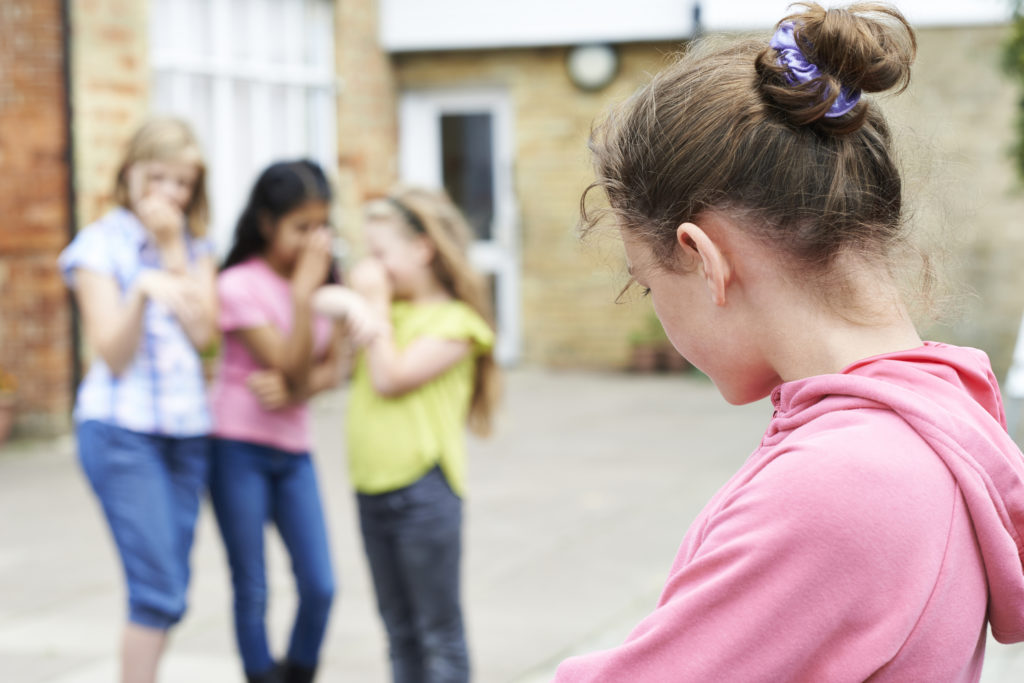TAKE ACTION TO STOP BULLYING

Many parents remember having difficulties with other kids in school. Maybe you were picked on as a kid, or had a bully that made you miserable. Perhaps you felt safe once you got home and could relax with your family. Unfortunately, bullying today isn’t like it used to be. It can extend beyond the school boundaries and into the home, making it especially important for teachers and parents to know how to spot it and what to do.
Bullying is defined as an imbalance of power resulting in repetitive hurtful behaviors. There are two types of bullying, direct and indirect. Direct bullying is often physical, but may include teasing, taunting, name-calling or destruction of property. Indirect bullying is not always as overt, and may involve spreading rumors, intentionally leaving someone out, or cyberbullying. Most bullying happens in middle school, though it is reported in all age groups.
The most common types are verbal and social bullying, so it may not be as easy to recognize as a child being physically abused. Parents should look for warning signs like unexplained injuries, lost property, frequent headaches or stomachaches, a change in eating habits, difficulty sleeping or nightmares. Some kids lose interest in school work, and may try to fake an illness to skip school or ask to stay home. If a friend group is the source of the bullying behavior, children may suddenly avoid kids who were previously friends, or social situations that were previously fun. Some children may express feelings of helplessness, sadness, anxiety or poor self-esteem, and may even engage in harmful or self-destructive behaviors, such as running away, cutting, or talking about suicide.
Children involved in bullying come from all backgrounds. Kids who bully could be either well connected socially or marginalized, and may be bullied by others as well. The effects of bullying can be far reaching; bullies, the bullied, and bystanders can all be affected into adulthood. For example, those who are bullied are more likely to have depression, anxiety, and vague health complaints (such as headaches or stomachaches). Bullies are more likely to have issues with drug and alcohol use, may get in trouble with the law, and are more likely to abuse future partners. Bystanders who witness bullying have a higher rate of school absenteeism, as well as drug and alcohol use. The risk of suicide in bullying is also increased, though bullying is not often the only cause, and most children who are bullied do not have suicidal thoughts.
It is important for parents, educators, and the community to be aware of bullying and to know how to help. Here are some tips to help stop and prevent bullying.
• Support those who are bullied: Ask the child what can be done to make them feel safe. Assure them that it is not their fault, and try not to disrupt the child’s routine. Don’t encourage children to ignore it or fight back, and let the school know so they can address the bully and involve his or her family. If physical help is needed, don’t hesitate to call your CPCMG provider, who can help provide other resources to ensure that your child is healthy and safe.
• Let bullies know their behavior is harmful: Help them by giving specific examples of hurtful behavior and calmly make it clear that bullying is taken seriously and will not be tolerated. Work with the child to understand some of the reasons he or she bullied another person. Use consequences that involve learning or building empathy to help prevent future bullying. Involve the kid who bullies in making amends or repairing the situation to help them see how their actions affect others. This may include writing a letter of apology, or repairing or replacing damaged property.
• Avoid punishment: Suspensions and expulsions don’t reduce bullying behavior, and shouldn’t be used in schools. In addition, many schools may try to mediate or facilitate conflict resolution between the bully and the child being bullied, but because of the imbalance of power, there is not equal blame on both children. Some kids are more upset by having to sit down with their bully, and may internalize some blame when they in fact did nothing wrong. Bullies also tend to reinforce the behavior in others, so group therapy is generally not helpful.
Bullying is unfortunately quite prevalent in today’s schools, but it doesn’t have to be a fact of life! No kid deserves to be bullied, and everyone should feel safe at school. With awareness of the types of bullying, warning signs, and what to do about bullying, parents should feel empowered to help their children through any incidents.
For more information on bullying, please visit www.stopbullying.gov
You can read about the AAP’s Health initiative to increase resilience in the face of bullying here:
https://www.aap.org/en-us/advocacy-and-policy/aap-health-initiatives/resilience/Pages/Bullying-and-Cyberbullying.aspx

